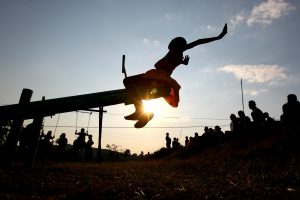Traction Together

A moving installation of playground seesaws along the U.S. and Mexico border recently won a major design award from the London Design Museum. The “Teeter Totter Wall” features seesaws in vivid pink, one seat reaching into the United States, the other seat threaded through the border fence to reach into Mexico. On the day of the installation, the design piece was a site of active play, laughter, and connection.
Meanwhile, I have been learning about another sort of “teeter tottering,” “pendulation” and “resourcing,” two techniques in somatic, or body-based, trauma healing. David Treleaven, author of Trauma Sensitive Mindfulness, recently explained that they are particularly relevant to navigating the turbulence that is 2021. With the trauma of the pandemic and violence such as the January 6 attack on the U.S. Capitol, many seek to stay engaged in movements for greater justice. It’s a key time to practice mindfulness.
Resourcing involves identifying and then emotionally or physically drawing upon elements of one’s surroundings that have a positive, sustaining influence. For me, it is the feeling of satisfaction and warmth I find in tending my house plants, especially after stepping away from a pandemic era zoom call. Drawing on sources of grounding, calm, or pleasure, resourcing is especially helpful when trying to engage difficult or traumatic areas. So it is that I find myself holding a ponytail palm in my lap during intense online sessions, running my fingers through its plant “hair.”
Pendulation involves shifting the focus of your attention. When encountering difficult or traumatic stimuli, one can pendulate back into the first tool, resourcing. You can shift out of engagement with painful encounters and ground for a moment in the calming resources you have identified. It’s a bit like a seesaw: balancing across a fulcrum of difficulty and resting on a familiar resource, back and forth again. Treleaven stresses that pendulating is different from bypassing, dissociation, or denial. It is a kind of responsive and responsible engagement that helps increase capacity for growth and healing. (To learn more about these and other mindfulness tools, see Treleaven’s book or explore his online resources.)
I suggest that pendulation offers a practice not only for individuals but for groups working together. It can help offices, work teams, or political groups work productively in a time of challenges. Through it, we increase our group capacity to stay alert to the injustices we seek to transform. As Kandace Montgomery and Miski Noor of the Black Visions Collective discuss in the Irresistible podcast, the daily toll of such work is hard on physical and emotional health.
In short, pendulation is for everyone because, as I have explored previously on this blog, trauma surrounds us daily.
The Teeter Totter Wall installation was brief. But it is both a symbolic and physical depiction of what pendulation and resourcing look like on a collective level: intentional playfulness in interface with traumatic reality—just as children and parents laugh and snap pictures at a site of division and much suffering. The seesaw makes a pulsing, playful rhythm when one seat bumps the ground, bounces, and pushed forward across the fulcrum again. Pendulating this way as a group, we collectively resource our resilience together. It’s not an “extra” for the occasional group retreat; it is how we do productive work in a traumatic world.
If for individuals, resourcing involves houseplants, a walk, or a favorite pillow or tea, what might it involve on an organizational level? The pink seesaws at the border are our cue to a little playfulness: fifteen minutes of regular office plant care (picture the growing lushness of the office over time)? A bring-your-pet-to zoom? A (physical) stroll around a block? An online walk with everyone on earbuds and mobile devices? Reading aloud a passage from a novel or briefly working together on a big puzzle midway through each agenda? How about a quick nerf basketball round? Theater games or a round of cards like the Oracle of Transfeminist Technologies? Or the more obvious choices like breathing exercises or gentle physical stretches.
It can be synchronizing your breath together in the middle of street protest, as somatics teacher Prentis Hemphill describes. It can be role playing games with your rabbi and congregation. Or as The Nap Ministry shows us, it can be scheduling naps into the daily office schedule, particularly for those healing a legacy of forced, ceaseless labor. It can be a snowball fight for those keeping vigil at George Floyd Square this winter, a flurry of fun and Black joy even at a place marked by racist trauma.
Perhaps the familiar coffee breaks, snacks, or meals together are not just “time off.”
Pendulation will feel forced or arbitrary unless the group first identifies what works for them and keeps updating it. Resources that work for a group will be ones that account for everyone’s access needs. Group pendulation also needs an easy “opt out” if the selected resource does not work for a person on any given day. You have to be able to hop off the see-saw. Group pendulation allows us to learn from each other’s choices. I can’t imagine myself playing nerf basketball as a calming resource but I might be surprised doing it with others.
Resmaa Menakem, in his work on healing racialized trauma, emphasizes returning repeatedly to body-centered practices in community together. Staci K. Haines stresses the political nature of all somatic work and describes how practices of presence and embodiment facilitate social change. adrienne maree brown insists on pleasure—actual savory, sensual pleasure—as an essential resource for activists. In an interview with brown in Pleasure Activism, Alta Starr says, “Yes, I recommend building the muscle of feeling pleasure, because I’ve noticed the world conspires to keep our attention elsewhere.”
Indeed, an unjust world always wants to keep our attention away from the resources that could undo it. Pendulation beckons us into them. Practicing pendulation in your working groups may at first feel as incongruent as a playground at a border wall, yet it’s about navigating a world of immense injustice with the capacity to keep going together.
#
Rev. Dr. Anna Mercedes is Associate Professor of Theology and Gender Studies at the College of Saint Benedict and Saint John’s University and is ordained in the Evangelical Lutheran Church in America. She is co-director of the Becoming Community grant funded by the Andrew W. Mellon Foundation, and director of a project grant on White Privilege and Theological Pedagogy funded by the Wabash Center. She is on instagram @pastorannamercedes and is the author of Power For: Feminism and Christ’s Self-Giving.
Counterpoint blogs may be reprinted with the following acknowledgement: “This article was published by Counterpoint Navigating Knowledge on 03 February 2021.”
The views and opinions expressed on this website, in its publications, and in comments made in response to the site and publications are those of the author(s) and do not necessarily reflect the views and opinions of Counterpoint: Navigating Knowledge, its founders, its staff, or any agent or institution affiliated with it, nor those of the institution(s) with which the author is affiliated. Counterpoint exists to promote vigorous debate within and across knowledge systems and therefore publishes a wide variety of views and opinions in the interests of open conversation and dialogue.
Photo credit: Jon Hrusa, USAID on Pixnio, Creative Commons.



